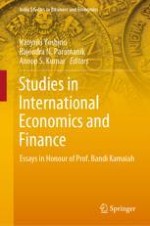2022 | OriginalPaper | Buchkapitel
Official Interventions in the Foreign Exchange Market: Implications for Exchange Rate and Its Volatility
verfasst von : Hersch Sahay, M. Ramachandran
Erschienen in: Studies in International Economics and Finance
Verlag: Springer Singapore
Aktivieren Sie unsere intelligente Suche, um passende Fachinhalte oder Patente zu finden.
Wählen Sie Textabschnitte aus um mit Künstlicher Intelligenz passenden Patente zu finden. powered by
Markieren Sie Textabschnitte, um KI-gestützt weitere passende Inhalte zu finden. powered by
